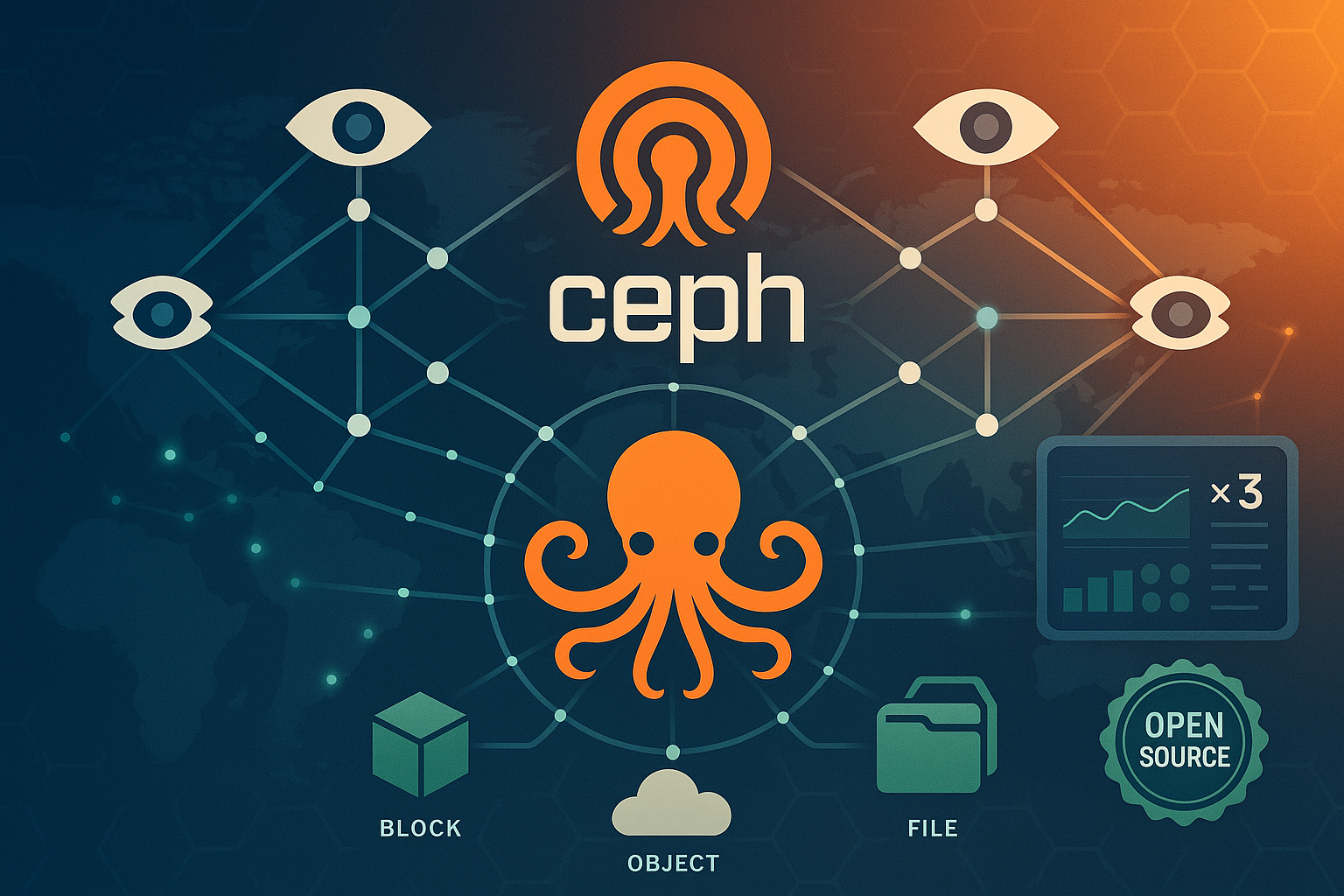
Ceph Administration – Master Open Source Distributed Storage
Learn to deploy and manage Ceph storage clusters to build reliable, high-performance, and scalable distributed storage infrastructure. Hands-on 3-day training covering RADOS architecture, core components, and basic administration.
Objectifs de la formation
Upon completion of this training, you will be able to:
- Understand Ceph architecture and the RADOS (Reliable Autonomic Distributed Object Store) system
- Install and configure a functional Ceph cluster using Cephadm
- Manage core components: Monitors, OSDs, Managers, and MDS
- Implement block storage with RADOS Block Device (RBD)
- Deploy object storage via RADOS Gateway (RGW) with S3 compatibility
- Configure file storage using CephFS
- Administer pools and manage data replication
- Use the Ceph dashboard for graphical monitoring
- Diagnose and resolve common issues
- Apply best practices for performance and security
Public concerné
This training is designed for:
System Administrators
Linux professionals looking to evolve into distributed storage administration and acquire Software-Defined Storage skills
Infrastructure Engineers
Responsible for deploying and managing scalable storage infrastructures for modern datacenters
Cloud Architects
Experts seeking a high-performance open source storage solution as an alternative to expensive proprietary solutions
OpenStack/Kubernetes Administrators
Professionals wanting to integrate Ceph as a storage backend for their cloud platforms
DevOps Engineers
Developers and operations staff looking to automate storage provisioning with Ansible
Training adapted for French-speaking African professionals seeking sovereign and cost-effective storage solutions.
Prérequis
Technical Prerequisites
Required
- Linux Administration: Proficiency in basic commands, systemd service management, file editing
- Storage Concepts: Understanding of basic concepts (partitions, file systems, RAID)
- TCP/IP Networking: Fundamental knowledge (IP addressing, ports, protocols)
- Shell Scripting: Ability to read and understand simple Bash scripts
Recommended
- Experience with virtualization (KVM, VMware)
- Knowledge of distributed architectures
- Python basics (for automation scripts)
- Familiarity with high availability concepts
Required Hardware Configuration
For online hands-on labs, each participant must have:
- Stable internet connection (minimum 10 Mbps)
- Modern web browser (Chrome, Firefox, Edge)
- SSH client (Terminal, PuTTY, or equivalent)
- Lab environment provided in ECINTELLIGENCE cloud
Programme détaillé
Detailed Training Program
Day 1: Fundamentals and Ceph Architecture
Module 1: Introduction to Distributed Storage and Ceph (3h)
- Storage evolution: from DAS/NAS/SAN to Software-Defined Storage
- Traditional storage challenges and distributed storage advantages
- Ceph project history and philosophy
- RADOS architecture: the heart of Ceph
- Key concepts: pools, placement groups (PGs), CRUSH map
- Use cases and success stories in Africa
- Comparison with other solutions (GlusterFS, MinIO)
Exploring a demo Ceph cluster, analyzing the architecture
Module 2: Essential Ceph Components (4h)
- Monitors (MON): Cluster map and quorum management
- Role in cluster consistency
- Quorum configuration (3, 5, 7 monitors)
- Epoch and version management
- OSDs (Object Storage Daemons): Data storage
- Disk and partition management
- Replication and recovery process
- Journal and metadata
- Managers (MGR): Metrics and plugins
- Web dashboard
- Prometheus, Zabbix modules
- RESTful API
- MDS (Metadata Server): For CephFS
- Metadata cache
- Active/Standby configuration
Installing a 3-node Ceph cluster with Cephadm (Reef 18.2)
Day 2: Deployment and Storage Types
Module 3: Deployment with Cephadm (3h)
- System and network prerequisites for Ceph
- Cluster bootstrap with cephadm
- Adding nodes and OSDs
- Configuring public and cluster networks
- Service management with orchestrator
- Upgrading to Squid 19.2
- Deployment strategies: All-in-one vs distributed
Complete cluster deployment, adding nodes, network configuration
Module 4: Block Storage with RBD (2h)
- RBD architecture and operation
- Creating and managing RBD images
- Snapshots and clones
- Advanced features: layering, exclusive-lock
- Integration with hypervisors (KVM/QEMU)
- Mapping volumes on Linux clients
- Performance tuning for database workloads
Creating RBD images, snapshots, client mounting, performance testing
Module 5: Object Storage with RGW (2h)
- Object storage concepts: buckets and objects
- RADOS Gateway deployment
- Multi-site and zone configuration
- S3 and Swift APIs: compatibility and differences
- User and quota management
- Bucket policies and ACLs
- Use cases: archiving, backup, CDN
RGW deployment, bucket creation, testing with AWS CLI and s3cmd
Day 3: Advanced Administration and Optimization
Module 6: File Storage with CephFS (2h)
- CephFS architecture: MDS and data/metadata pools
- MDS deployment and configuration
- Mounting CephFS: kernel client vs FUSE
- Subvolume and snapshot management
- Quotas and layouts
- NFS and SMB export via Ganesha
- Use cases: file sharing, home directories
CephFS configuration, client mounting, load testing
Module 7: Administration and Monitoring (3h)
- Pool and CRUSH Management
- Pool types: replicated vs erasure coded
- CRUSH map modification
- Custom placement rules
- Dashboard and Monitoring
- Navigating the Ceph dashboard
- Key metrics: IOPS, throughput, latency
- Prometheus/Grafana integration
- Daily Maintenance
- Essential commands: ceph status, health, df
- OSD management: in/out, up/down
- Scrubbing and deep-scrub processes
Monitoring configuration, creating custom dashboards
Module 8: Performance and Troubleshooting (2h)
- Performance analysis with ceph bench
- Optimization: cache tiering, optimal placement
- Troubleshooting: slow requests, PG states
- Recovery and backfilling: management and priorities
- Practical failure scenarios and resolutions
- Backup and disaster recovery strategies
- Future developments: NVMe-oF, compression
Failure simulation and recovery, production cluster optimization
Certification and Assessment
- Knowledge validation quiz at the end of training
- ECINTELLIGENCE training certificate
- Complete course materials in English (250+ pages)
- Lab access for 30 days after training
- Optional preparation for Red Hat Ceph certification
- Integration into the French-speaking Africa Ceph community
Certification
À l'issue de cette formation, vous recevrez une attestation de participation délivrée par ECINTELLIGENCE.
Autres formations qui pourraient vous intéresser
Prêt à développer vos compétences ?
Rejoignez des centaines de professionnels qui ont fait confiance à ECINTELLIGENCE pour leur montée en compétences.
Voir toutes nos formations